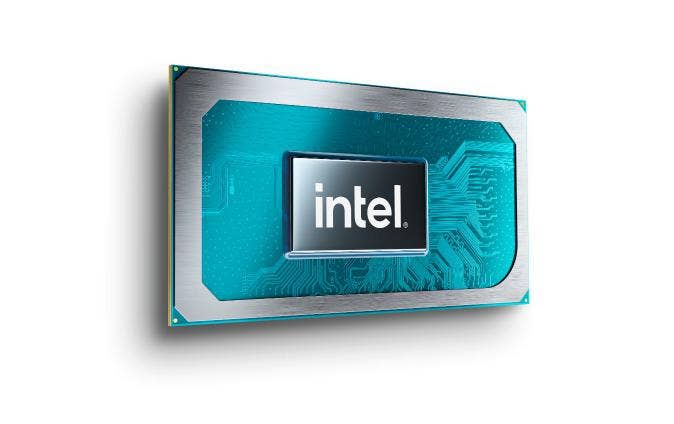Intel Launches 11th-Gen Core, Xeon vPro CPUs For Mobile Workstations
The chipmaker’s new 10-nanometer CPUs for high-end laptops, code-named Tiger Lake H, go up to 5GHz and eight cores for demanding content creation and business applications, and Intel says they can best rival AMD across multiple applications. ‘If performance improves productivity, these new CPUs will drive productivity increases,’ an Intel rep says.

Intel has unleashed a new wave of 11th-generation Core processors, this time built for those who need a mobile workstation capable of doing heavier lifting for content creation and business applications than the increasingly popular ultra-thin laptops entering the market.
The new Core H-Series lineup, code-named Tiger Lake H, includes five Core and Xeon CPUs that come with Intel’s vPro platform capabilities for enterprise management, security and reliability, expanding upon the first batch of 11th-generation vPro processors that came out for ultra-thin laptops at the beginning of the year. New platform capabilities include support for DDR4 memory, Thunderbolt 4, 20 lanes of PCIe 4.0, Intel Killer Wi-Fi 6E, CPU-connected storage as well as Optane H20 storage.
[Related: Pat Gelsinger: Intel Needs To Be Consistent, Reliable For Partners]
The Tiger Lake H CPUs — which include five consumer variants aimed at gaming and content creation — are expected to go into more than 80 mobile workstations this year for the gaming, content creation and commercial segments, and roughly 15 of them will use the vPro variants. The processors feature up to eight cores and, for the first time with Intel’s 10-nanometer manufacturing process, reach up to 5GHz in frequency with Intel Turbo Boost Technology.
Intel claims they can best AMD’s new Ryzen 5000 H-Series CPUs across multiple games and in video creation, photo processing and Microsoft Office workloads. Compared to AMD’s eight core Ryzen 9 5900HX, Intel’s new flagship, eight-core Core i9-11980HK consumer CPU can improve frames per second from 11-26 percent for popular games like Total War: Three Kingdoms and GRID 2019, according to tests run by Intel. It was also up 14 percent faster for Office applications, 18 percent faster for Adobe After Effects video editing and 24 percent faster for Adobe Photoshop Elements photo editing, Intel said.
The chipmaker demonstrated that even the new mid-range, six-core Core i5-11400H was on par with AMD’s Ryzen 9 5900HX. For Hitman 3, Total War and War Thunder, the new Core i5 processor was only a few points short of reaching the frames per second provided by the Ryzen 9. In GRID 2019, Far Cry: New Dawn, Rainbow Six Siege and Troy: A Total War Saga, the Core i5 provided 3 percent, 4 percent, 4 percent and 12 percent more frames per second, respectively.
For customers looking to refresh older Intel-based mobile workstations, the chipmaker said the new enterprise-grade Core vPro i9-11950H can provide double-digit performance gains ranging from 11-29 percent over its 10th-generation Core vPro i9-10885H. When compared to the ninth-generation Core vPro i7-9850H, the new Core vPro i9’s gains grow to 24-75 percent. The benchmarks covered workloads for financial services, product development, single-threaded compute and multi-threaded compute.
“If performance improves productivity, these new CPUs will drive productivity increases,” said Christopher Yahna, senior director of product management for business client platforms at Intel, in a pre-briefing with journalists.
The Tiger Lake H processors are based on the same Willow Cove core microarchitecture and 10nm SuperFin manufacturing process that serve as the basis for Intel’s 11th-generaton Core mobile processors — code-named Tiger Lake, minus the “H” — that launched last fall for ultra-thin laptops.
While the new CPUs don’t reach the 5.3GHz maximum frequency of Intel’s 10th-generation Core H-Series CPUs that launched last year, Intel engineering executive Boyd Phelps said the Tiger Lake H chips benefited from an increase in instructions per clock and a decrease in voltage associated with the 10nm Willow Cove architecture that allowed Intel to provide better performance. This improved voltage-frequency curve allowed Intel to hit 5GHz at a lower voltage than the previous generation, he added.
“We feel pretty proud about how we’ve dialed that in, in terms of frequency, IPC power and giving the best overall experience we can,” he said.
Ryan Shrout, chief performance strategist at Intel, said Tiger Lake H’s improvements in instructions per clock, core count and frequency, plus the CPU’s DL Boost instruction set and Xe integrated graphics, allowed Intel to beat AMD’s top Ryzen 5000 H-Series CPU across tested content creation workloads.
“One of the benefits of the Intel architecture and the Tiger Lake H product family is you get to take advantage of all the XPU goodness that we have built into the product, as well as getting the core, frequency and IPC improvements that you see with this generation,” he said.
The vPro variants of Tiger Lake H come with Intel Hardware Shield, a set of silicon-level security features that protects the system underneath and above the BIOS level and uses GPU resources to perform advanced threat detection workloads, lowering the strain on the CPU.
Other vPro features include Intel Control-Flow Enforcement Technology, which is meant to protect against common malware attacks, and Intel Active Management Technology with Intel Endpoint Management Assistant, which enables remote management and maintenance at the BIOS level; and Intel Total Memory Encryption, which enables encryption of the entire system memory.